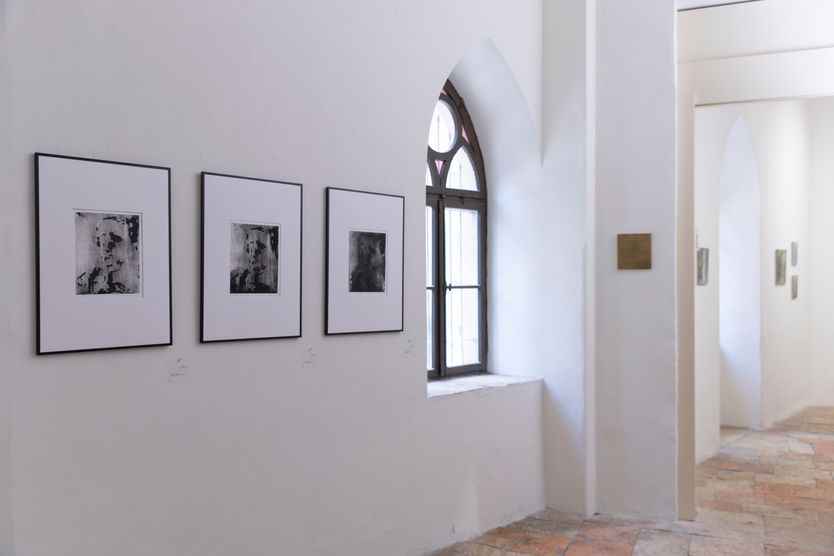
The Book of Esther is an important, unique spiritual and religious asset and an inalienable cultural legacy of the Jewish people. Of the 24 books of the Hebrew Bible, only two are named for women: Ruth and Esther. In The Book of Esther, we uncover the Metamorphosis and heroism story of Esther, who changes her national destiny by being conscious of her religious legacy.
The exhibition presents the interpretations and the variety of possible contexts for reading the Book of Esther, which allows us to feel, even today, with vivid passion and interest, the relevance of this book to our history as a nation and as women.
We have chosen works by artists mostly from Italy and Israel, which interpret the themes and narratives in varieties of manners. The practice of disguise, of hidden identity, was given spiritual significance over the generations, and it characterizes other cultures. Some of the selected works are also our interpretation as curators of the scroll meanings and the symbolism surrounding it. This is done from a feminist, sociological, and historical perspective.
We refer in several works to the motif of concealment that is present in the book, first in that the explicit name of God does not appear in it, and also by the fact Esther is concealing her people and homeland.
“Tzon barzel,” the theme of the Sixth Jerusalem Biennale, is a Talmudic term referring to property that a woman brings with her into a marriage, and to which she retains ownership rights regardless of the fate of the marriage. This concept of an inalienable asset is used idiomatically in contemporary Hebrew to describe cultural riches. Threading explores the rich reservoir of cultural assets created by Jewish women, with an emphasis on textile arts as both medium and metaphor, highlighting fabrics as material and techniques such as weaving and embroidery as visual motifs. Strategies include upcycling fabrics with personal significance to create new artworks, and evoking traditional textile techniques, such as weaving and embroidery, deployed as visual motifs in other media, such as video, wood, metal, and paper.
In the exhibition, works by seven contemporary artists are displayed in conversation with historical Judaica, made and donated by women, from the collection of the Nahon Museum of Italian Jewish Art. Thanks to the inscriptions they embroidered on Torah binders, desk covers, and other ceremonial textiles, we know the names of the Jewish women from communities in Italy (16th-18th century) who created these beautiful works. Many of these synagogue textiles were made by repurposing fabrics from garments or household items, thereby transforming mundane articles from daily life into sacred objects.
Notably, this will be the first Israeli exhibition to include work by video art pioneer Beryl Korot (USA). She is joined by artists Lynne Avadenka (USA), Heddy Breuer Abramowitz, Linda Lieff Altabef, Andi Arnovitz, Raya Bruckenthal, and Rachel Tauber (all residing in Israel). The exhibition is organized by curator Emily D. Bilski.
גַּעְגּוּעִים הֵם כּמוֹ זְרָעִים
אמילי דיקינסון
גַּעְגּוּעִים הֵם כְּמוֹ זְרָעִים
בְּתוֹךְ הָאֲדָמָה,
מְצַפִּים, מַאֲמִינִים:
בַּסוֹף יִקְרֶה דְּבָר-מָה.
מַה הַשָּׁעָה? הֵם לֹא יוֹדְעִים -
אִם קַר בַּחוּץ אוֹ חַם,
גַּעְגּוּעִים הֵם כְּמוֹ זְרָעִים
עָמוֹק בַּחֲשֵׁכָה.
עבור האמנית זיכרונות הם חומר גלם מוחשי. מתוך רגעים, חוויות, חפצים ותמונות מהעבר, רוקמות האמניות את עבודתן. לענייננו, חמש אמניות: יעל בוברמן-אטאס, נאוה ט' ברזני, מיכל מיקי גמזו, אליזבטה זיידנר ונעמי טדסקי בלנקט. חמישה גופי עבודות, חמישה זיכרונות, חמש טכניקות. לכל טכניקה ולכל חומר דרך אחרת לזכור ולהיזכר. העבודות מזמינות להתקרב ולהתבונן. זוהי אמנות קשובה, יכולת נשית לראות בדבר הקטן לכאורה, את מלוא גודלו ועצמתו.

%20(6).png)


















